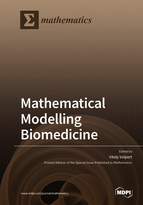Mathematical Modelling in Biomedicine
A special issue of Mathematics (ISSN 2227-7390). This special issue belongs to the section "Engineering Mathematics".
Deadline for manuscript submissions: closed (30 June 2020) | Viewed by 31940
Special Issue Editor
Interests: mathematical modeling in biology and biomedicine
Special Issues, Collections and Topics in MDPI journals
Special Issue Information
Dear Colleagues,
Mathematical modeling in biomedicine is a rapidly developing scientific field due to its importance for the fundamental scientific research and for the applications to public health. Cardiovascular diseases, cancer, and infectious diseases are the main causes of mortality and morbidity in the world, and they represent the major challenge for society. Mathematical modeling of physiological processes in normal and pathological situations can help to understand the underlying processes and to develop an efficient treatment. In spite of the considerable progress in this area during the last decade, many questions here remain open because of their complexity and the interpatient variability.
The purpose of this Special Issue is to present the state of the art in mathematical modeling of cardiovascular diseases, cancer, immunology and infectious diseases, and other topics related to normal and pathological human physiology. Mathematical analysis, numerical methods and scientific computing of biomedical models will also be considered.
Prof. Dr. Vitaly Volpert
Guest Editor
Manuscript Submission Information
Manuscripts should be submitted online at www.mdpi.com by registering and logging in to this website. Once you are registered, click here to go to the submission form. Manuscripts can be submitted until the deadline. All submissions that pass pre-check are peer-reviewed. Accepted papers will be published continuously in the journal (as soon as accepted) and will be listed together on the special issue website. Research articles, review articles as well as short communications are invited. For planned papers, a title and short abstract (about 100 words) can be sent to the Editorial Office for announcement on this website.
Submitted manuscripts should not have been published previously, nor be under consideration for publication elsewhere (except conference proceedings papers). All manuscripts are thoroughly refereed through a single-blind peer-review process. A guide for authors and other relevant information for submission of manuscripts is available on the Instructions for Authors page. Mathematics is an international peer-reviewed open access semimonthly journal published by MDPI.
Please visit the Instructions for Authors page before submitting a manuscript. The Article Processing Charge (APC) for publication in this open access journal is 2600 CHF (Swiss Francs). Submitted papers should be well formatted and use good English. Authors may use MDPI's English editing service prior to publication or during author revisions.
Keywords
- Biomedical modeling
- Cardiovascular diseases
- Cancer
- Immunology
- Infectious diseases
- Mathematical analysis
- Numerical simulations






